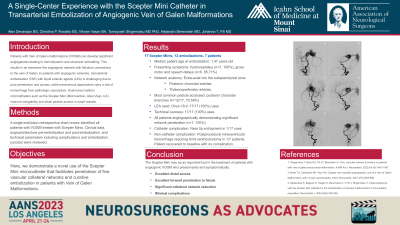A Single-Center Experience with the Scepter Mini Catheter in Transarterial Embolization of Angiogenic Vein of Galen Malformations
A Single-center Experience with the Scepter Mini Catheter in Transarterial Embolization of Angiogenic Vein of Galen Malformations
Friday, April 21, 2023


Alex Devarajan (he/him/his)
Medical Student
Icahn School of Medicine at Mount Sinai
New York, New York, United States
ePoster Presenter(s)
Introduction: Patients with Vein of Galen malformations (VOGM) can develop significant angiogenesis leading to hemodynamic and structural remodeling. This results in an extensive fine angiogenic network with fistulous connections to the vein of Galen. In patients with angiogenic networks, transarterial embolization (TAE) with liquid embolic agents (LEA) is challenging due to poor penetration and access, while transvenous approaches carry a risk of hemorrhage from pathologic vasculature. Dual-lumen balloon microcatheters such as the Scepter Mini (Microvention, Aliso Viejo, CA) improve navigability and distal pedicle access in small vessels. Here, we report on the use of the Scepter Mini for TAE of angiogenic VOGM.
Methods: A single-institution retrospective chart review identified all patients with VOGM treated with Scepter Minis. Clinical data, angioarchitecture pre-embolization and post-embolization, and technical parameters including complications and embolization success were reviewed.
Results: 17 Scepter Mini catheters were used in 12 embolizations of seven patients with VOGM. The median patient age at embolization was 1.47 years old. Patients presented with hydrocephalus (n=7, 100%) and gross motor and speech delays (n=6, 85.71%). Anatomically, fine vascular networks developed extra-axially into the subependymal zone from the anterior choroidal, posterior choroidal, and thalamoperforator arteries. Distal access to the network and VOGM was most commonly achieved within posterior choroidal branches (n=12/17, 70.59%). Successful embolization with Onyx-18 was achieved in 17/17 (100%) uses with all patients angiographically demonstrating significant network penetration (n=7, 100%). Tip entrapment of the Scepter Mini with concurrent LEA cast displacement occurred in 1/17 uses. One patient experienced postprocedural intraventricular hemorrhage requiring third ventriculostomy. This patient had improvement in developmental milestones on follow up.
Conclusion : The Scepter Mini provided excellent distal access with penetration to the fistula and subsequent extra-axial network reduction with few complications. The Scepter Mini may be an important tool in the treatment of patients with angiogenic VOGM who present early and symptomatically.
Methods: A single-institution retrospective chart review identified all patients with VOGM treated with Scepter Minis. Clinical data, angioarchitecture pre-embolization and post-embolization, and technical parameters including complications and embolization success were reviewed.
Results: 17 Scepter Mini catheters were used in 12 embolizations of seven patients with VOGM. The median patient age at embolization was 1.47 years old. Patients presented with hydrocephalus (n=7, 100%) and gross motor and speech delays (n=6, 85.71%). Anatomically, fine vascular networks developed extra-axially into the subependymal zone from the anterior choroidal, posterior choroidal, and thalamoperforator arteries. Distal access to the network and VOGM was most commonly achieved within posterior choroidal branches (n=12/17, 70.59%). Successful embolization with Onyx-18 was achieved in 17/17 (100%) uses with all patients angiographically demonstrating significant network penetration (n=7, 100%). Tip entrapment of the Scepter Mini with concurrent LEA cast displacement occurred in 1/17 uses. One patient experienced postprocedural intraventricular hemorrhage requiring third ventriculostomy. This patient had improvement in developmental milestones on follow up.
Conclusion : The Scepter Mini provided excellent distal access with penetration to the fistula and subsequent extra-axial network reduction with few complications. The Scepter Mini may be an important tool in the treatment of patients with angiogenic VOGM who present early and symptomatically.
